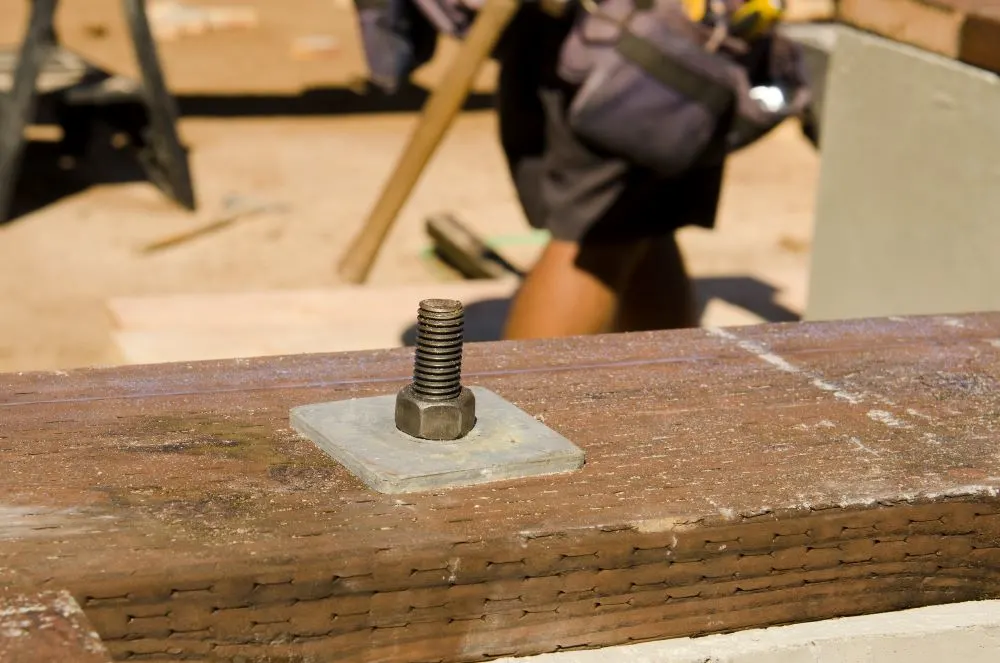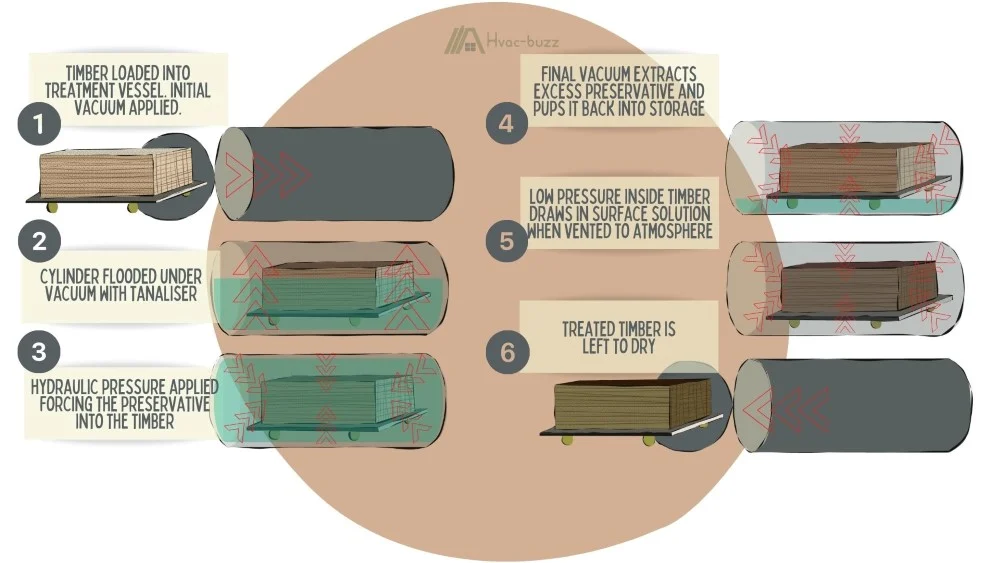Wooden foundation framing is an eco-friendly choice that is easy to install. The only questionable part would be preservative treatment. Well, the answer, while depending on the wood you use, is straightforward and clear-cut.
Building regulations require that wood be treated in basements and foundations when it has contact with the ground or weather. So, we will look at the coding regulations, the type of preservative to be used for the treating, why treating is important, and how to recognize treated wood, as well as some alternative materials.

As per the IRC, basement wall bottom plates must be treated. Exceptions: if naturally durable wood is used or the plate is supported by metal pedestals or concrete piers. Untreated wood must still be separated from pedestals or piers by moisture barriers.
IRC Says Wood Must Be Preservative-Treated
Section R317.1.2 of the International Residential Code (IRC) states that wood in contact with the ground, embedded in concrete in contact with the ground, or exposed to the elements, must be approved standard wood that is pressure-preservative treated.
This treatment serves to protect the wood from decay and it does not only apply to bottom plates. You can find more information on where pressure-treated framing can and should be used in Can You Use Pressure Treated Wood for Interior Framing. Furthermore, it is even required for bottom plates of floating walls.
So, your framing bottom plate must be treated, unless it is supported by any metal pedestals or concrete piers that protrude from the slab by 1”. Don’t forget that there should still be a moisture barrier between the concrete piers and the wooden columns to separate them.

With regards to the rest of the frame, you do not need to pressure-treat the wood if you provide a gap between it and the basement wall.
Allowable Preservative Treatment
The IRC, Section R317.1, approves of the preservatives that are approved by the American Wood Protection Association (AWPA). The AWPA uses a Use Category System (UCS) to divide the different conditions and criteria of wood.
Permanent foundations fall under the category UC4B. The preservatives appropriate for treating wood are below.
- Alkaline copper quaternary (ACQ).
- Copper: prevents bacteria and fungus.
- Boric acid: biocide, which is a fungicide, pesticide, and herbicide. Particularly useful as an insecticide.
- Quaternary ammonium salts: preservative and biocide.
- Copper azole (CA); sometimes marketed as copper boron azole (CBA).
- Copper: prevents bacteria and fungus.
- Tebuconazole: controls fungi.
- Boric acid (CBA includes this): biocide.
(Please note: that chromated copper arsenate (CCA) is not permitted for wood treatment in the USA.)
UC1 and UC2 are for wood that is not in contact with the ground. This is not your foundation wood, but could help with other wood in the basement. Technically, you are not required by the IRC to preservative treat wood that is not in contact with the ground (UC1 and UC2), but it might still be helpful to protect the wood from insects and wet.
Reasons Why Preservative Treatment Is Important
Because of the organic nature of wood, it is, therefore, subject to biodegradation and other degradation factors. This is problematic when you intend the wood to be permanent such as with a wooden foundation.
By using large quantities of preservatives to treat the wood you use, you protect permanent foundations from:
- Biodegradation.
- Decay.
- Wet and water damage.
- Fungi.
- Mold.
- Rot.
- Insects, like ants and termites, tunneling into and eating the wood.
The pressure treatment is done so that the wood can withstand the pressure from the surrounding soil and any environmental loads that might put extra pressure on the structure.

Without treating the wood, you are going to encounter several problems.
The wood of your foundation will age and weaken, losing structure and strength. This will lead to the wood collapsing as it will no longer be able to load-bear.
The wood will be impacted more severely by the temperature changes and moisture because it will be able to absorb more. The wood will lose integrity and wrap the more it changes with the weather conditions. Water will compromise the organic structure of the wood, expedite rotting and decay, as well as cause warping.
In a basement, this does not just affect the basement itself. Excess moisture affects the upstairs as well in several different ways.
Protecting your foundations from insects, like ants and termites, is important. Should your foundations become infested, you may not even realize you have a problem before your foundations have been consumed and bored into. This would cause your wooden foundation to collapse.
Without the pressure treatment, the wood of your foundations will warp and may snap and break as it cannot withstand the pressure loads of the soil (which is a lateral pressure), environment, and the house itself.
The framing bottom plate is an integral and crucial part of your foundation, and you do not want to have any of these problems occurring. So, you must treat the plate.
Recognizing Code-Compliant Treated Wood
Standard-approved wood should bear the quality mark of an accredited inspection agency, according to IRC Section R317.2. This will indicate that the wood is an appropriate grade.
You should be able to see an indication of the treatment process and what preservatives were used. The standard information you should see is, according to AWPA and IRC Section R317.2.1:
- Standard to which it was treated: AWPA U1, which indicates the AWPA standard.
- Use Category designation: such as UC4B to indicate what it can be used for.
- The preservative name or abbreviation.
- Minimum preservative retention: 0.60 for foundation lumber.
- Treatment plant identification.
- Quality mark.
- “Dry” designation if applicable.
The wood is unlikely to meet the criteria for use if you cannot find the quality mark, APWA U1, or category, so look carefully when picking out your wood.
You also need to ensure that any cut wood is resealed. If you are buying your framing wood from Home Depot, they will cut it for you, and you can talk to them about how to reseal the edges.
Alternative Naturally Durable Wood
Section R317.1 (IRC) does state that naturally durable wood can be used in place of preservative-treated wood.
The IRC requires the heartwood, which is the inner part of the tree that yields the hardest and densest timber, of certain tree species for it to classify as naturally durable wood.
Decay resistant:
- Cedar.
- Black walnut.
- Redwood.
- Black locust.
Termite resistant:
- Alaska yellow cedar.
- Western red cedar (including sapwood).
- Eastern red cedar.
- Redwood.
Corner sapwood is occasionally allowed to be used as long as 90% or more of the width on either side is made of heartwood.
Sources
https://www.fpl.fs.fed.us/documnts/fplrp/fplrp190.pdf
https://mtcopeland.com/blog/wood-foundations-pwf-pros-cons-and-considerations/
https://www.structuremag.org/?p=10105
https://www.sciencedirect.com/topics/agricultural-and-biological-sciences/tebuconazole
http://npic.orst.edu/ingred/ptype/treatwood/cazole.html
https://dolphinbay.co.za/acq-preservative/
https://codes.iccsafe.org/content/IRC2021P1/chapter-2-definitions#IRC2021P1_Pt02_Ch02_SecR202
